Acer V7-482PG-9884 Review: Everything You Need
by Jarred Walton on August 24, 2013 12:00 AM ESTAcer V7 Battery Life
So far we’ve looked at CPU and GPU performance metrics, but perhaps more important on any laptop is going to be battery life. Improving power use/battery life was one of Intel’s key goals with Haswell, and so far we’ve seen clear evidence of that in the Haswell laptops that we’ve reviewed. The Acer Aspire V7 confirms that trend, boasting some of the best (normalized) battery life figures that we’ve seen from a Windows laptop.
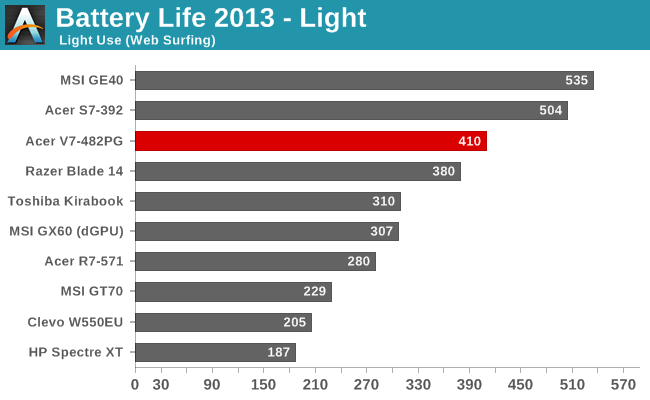
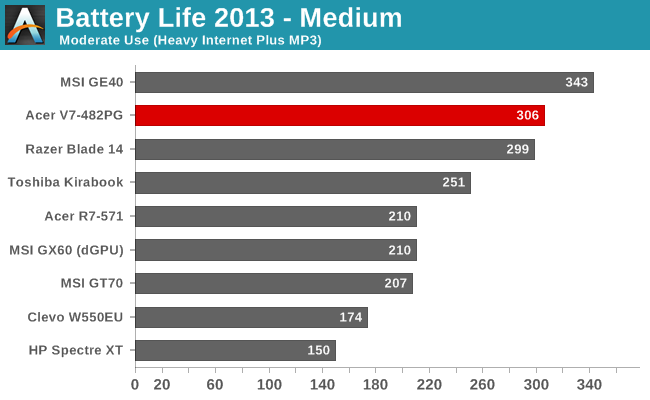
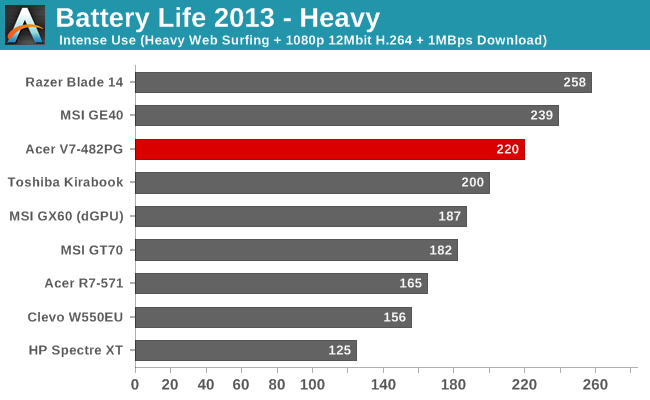
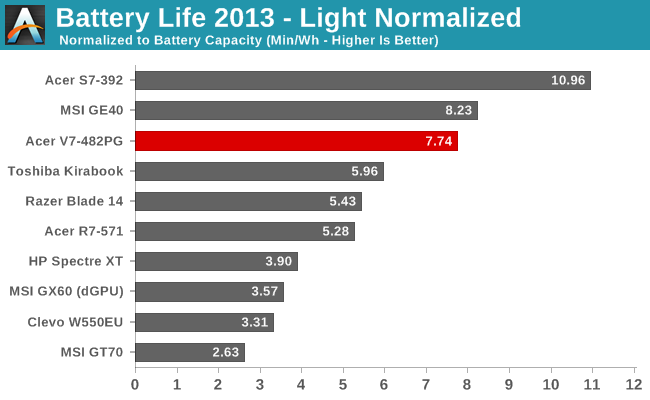
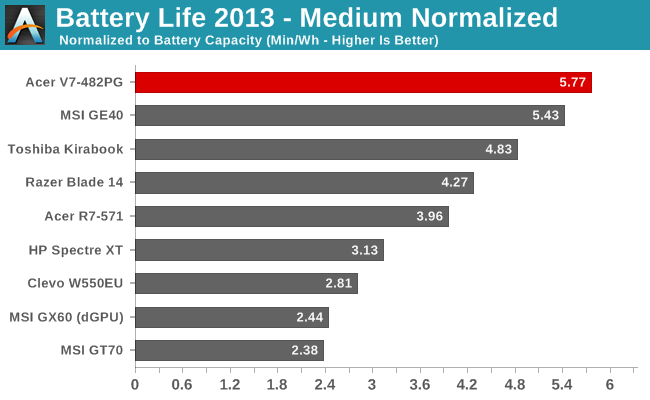
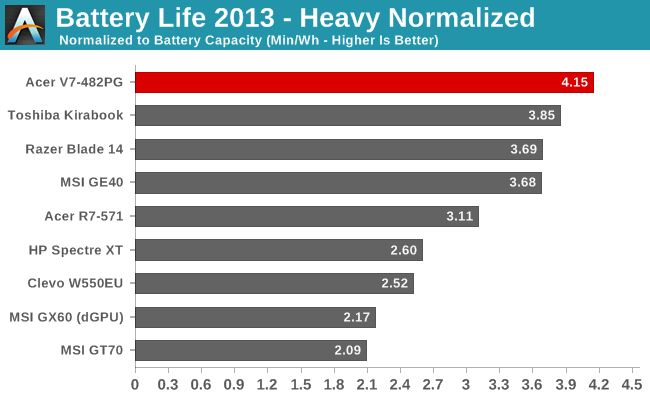
The 53.6 Wh battery isn’t the highest capacity battery you’ll find on market, but it’s the same capacity that Apple uses in the MacBook Air 13 (2013). What’s not the same is the battery life that you get with Windows compared to OS X. With Haswell, the Aspire V7 basically matches what Apple was able to do with the MacBook Air 13 (2012): around seven hours of battery life in our light workload. For reference, the new MBA13 delivered 11 hours in the same test. Still, the Haswell laptops are all posting significant gains over the previous generation Ivy Bridge laptops.
And thanks to NVIDIA’s Optimus Technology, even laptops with discrete GPUs like the MSI GE40 and Acer V7 don’t take a hit to battery life – at least when the GPU isn’t active. Power up the GPU and run a game, on the other hand, and the story changes quite a bit: we measured just 98 minutes of battery life looping 3DMark11 on the Acer V7 (with the GPU set to “prefer maximum performance” in the control panel and using the Balanced power profile). That might seem terrible, and it’s certainly not great, but higher performance GPUs are almost always throttled on battery power, regardless of what settings you use – the MSI GE40 delivered slightly less battery life in our simulated gaming test, with roughly the same performance as the Acer V7 under the same conditions. So basically, on battery power the GT 750M and GTX 760M aren’t all that different, despite the latter having twice as many shaders and substantially more memory bandwidth.
Getting back to the battery life aspect, the V7 posts good results certainly, but I was hoping for even a bit more from our first complete Haswell Ultrabook review. Perhaps the 14” touchscreen is part of the issue, as it could be sucking down precious milliwatts. Other components are also likely a factor, as the Acer S7-392 is quite close to the MBA13. Ultimately, we’re looking at average power draw for the entire laptop of around 7.7W in our Light test on the V7 compared to roughly 4.8W for the MBA13 in the same test under OS X; the S7 Haswell Ultrabook measured 5.4W, which is pretty close to the same sort of gap we’ve seen in the past. As for the V7, coming up with items to account for almost 3W is difficult.
I’m frequently amazed at how much better battery life is with Apple hardware under OS X. We’ve seen in the past that Apple usually optimizes (in a good way) quite heavily in their OS to achieve good battery life, and when you switch to Windows via Boot Camp you lose a lot of battery life. Anand didn’t test Windows battery life with the new MBA13, but I wonder what it’s like, because the usual 30% drop would put it on equal footing with something like the V7. I suspect with Haswell, the opportunities to further tune the OS and hardware for improved battery life are even greater, though, so we might see a 50% drop in battery life with the MBA13 under Windows.
If you need 10+ hours of battery life in Windows, it looks like you’ve got a couple options right now: get a system that’s not as fast (e.g. the V7 has a discrete GPU and hybrid storage with 12GB RAM while the S7 is iGPU only, pure SSD, and 8GB RAM), or find something with a higher capacity battery or a slice battery. For seven hours of useful work – and potentially eight or more if you turn the LCD brightness down a few more notches and don’t constantly surf the Internet – the V7 should be sufficient for most users.










62 Comments
View All Comments
lmcd - Saturday, August 24, 2013 - link
I'd personally bet you don't even need the dGPU. I'd consider picking up an ultrabook with the right size screen and screen res.I can't judge 3D Home Architect but based on what I'm seeing it seems legacy. I think iGPU graphics should handle it just fine, and again, a dGPU would be wasted.
I'd strongly recommend picking a Haswell-only model, though I'd consider waiting to see what Haswell with Iris HD Pro brings (power consumption).
One last question though: what screen res is that 24 inch monitor? 1920x1080 will be fine (and I don't think much else exists at that screen size) but I wonder how well 1440p would run off an iGPU (probably not that well).
JarredWalton - Saturday, August 24, 2013 - link
Yeah, what lmcd said. For the applications you're running, the dGPU isn't needed -- it's just taking space and perhaps a little bit of power. I'd estimate the 720M is only about 30-50% faster than the HD 4400, so if you could get something with HD 5000 the gap would be even smaller. We've got a laptop with Iris Pro 5200 Graphics inbound, but the cost may be too high relative to Optimus models to make it worthwhile.Of course, if you can't find another laptop with a decent 1080p display for less than $1050, the 15.6" V7 isn't terrible -- it's just not as good (IMO) as the smaller V7.
Bob Todd - Saturday, August 24, 2013 - link
I'm assuming that's a 47W quad you've got coming from the SKUs I've seen, but any insights into when we'll see the dual core 28W HD 5100 parts? My wallet is begging to be abused by a very portable machine that can last 12 hours in light duty and still play most current games (~720p/low). Preferably before my next flight to India :/.dareo - Sunday, August 25, 2013 - link
Thanks for the feedback. Since I'm giving myself to the end of the year for making the purchase, I'll throw this one into the spreadsheet that I'm using for evaluating alternatives.dareo - Saturday, August 24, 2013 - link
The monitor res is 1920x1080 as you suspected which, for what I do, is just fine.I'd agree that the iGPU is fine for 90% of what I do so that definitely makes it good enough. Nevertheless, that last 10% (3D Home Architect) can be frustrating at times. My current laptop has a Core i5 M430 and a GeForce 310M. Doing a 3D walkthrough of complex drawings is very choppy.
rootheday - Sunday, August 25, 2013 - link
Based on the benchmarks at notebookcheck.net, haswell iGpu in ultrabook 15w skus (hd4200, hd4400) are about 2x the performance of the 310m.powerfox - Saturday, August 24, 2013 - link
According to various things I've read online, that port on the back may or may not be a Mini DisplayPort. Are you able to test if it is and if 2560x1440 output is possible? I've been considering this computer, but connecting it to my U2711 is important to me. Thanks.JarredWalton - Saturday, August 24, 2013 - link
Sadly, I don't even had a DisplayPort capable LCD, let alone one with 1440p support. I've been using a couple older 30" DL-DVI displays for years, and have no reason to upgrade yet (and no space for another display). Acer calls it a mini-VGA, but you need an adapter for that, and apparently they also support a few other things with the port via adapters. But they do not guarantee displays will work. This is all based on information from the R7 though -- they don't have a spec sheet for the V7 posted yet, oddly enough.http://acer.custhelp.com/app/answers/detail/a_id/3...
hfm - Saturday, August 24, 2013 - link
Personally, for gaming, moving away from native resolution is the worst thing you can do. The Razer 14 even with it's questionable panel is in a different league for gaming concerns.davejake - Saturday, August 24, 2013 - link
Jarred, your reviews are the only ones I've really come to trust as I'm shopping for a new laptop. Thanks for the level-headed subjective analysis combined with the well-analyzed raw data. Whatever compensation you get for doing these reviews... it should be more!The only thing that is stopping me from snagging this laptop right now is that the specs on the (ever?) forthcoming Gigabyte p34g and p35k look compelling-- like the V7 on steroids without the touchscreen. What's the "major flaw" that you're concerned about with those? I, and I'm guessing many others, would be interested in your assessment. I'm guessing price, heat, battery life, and availability are the likely "gotchas." Thanks!